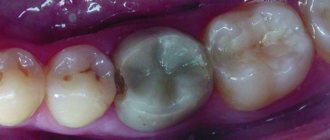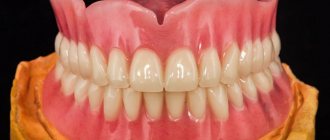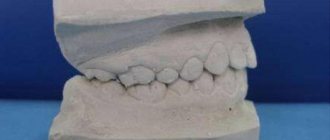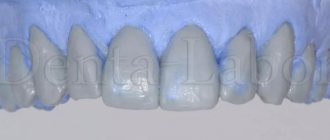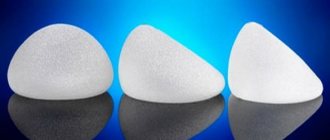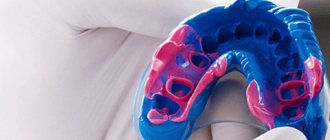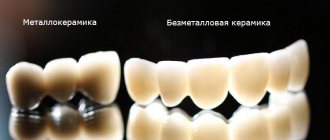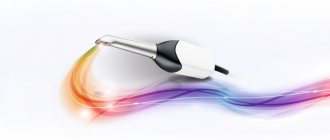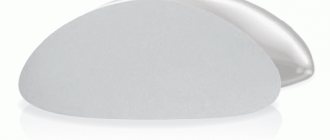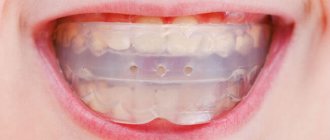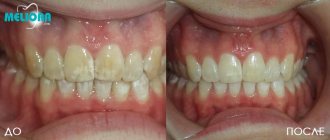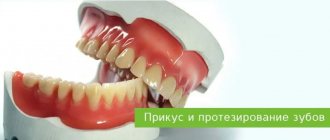Lavask wax is widely used in dentistry; it is used to create future crowns and bridge structures. Modeling wax Lavask has received well-deserved recognition among dentists; it is rightfully considered one of the best materials. Lavasc wax is used to create metal and non-metal prototypes of a future tooth. Today we will talk about Lavask modeling wax. Read the next article on the pages of the magazine, which will talk about the features of using Lavax wax.
Modeling wax Lavax
“Lavax” is a composition consisting of paraffin, natural and synthetic wax mass.
“Lavax” is a composition consisting of paraffin, natural and synthetic wax mass. Used to create prototypes of fixed prostheses: plastic crowns, half-crowns, inlays, facets, direct bridges. Available in the form of unpainted and painted sticks. The painted mass is used to model metal elements, and the unpainted mass is used to form prototypes of plastic parts of the prosthesis. Completely softens at a temperature of 55 – 60 °C. “Lavax” is moderately plastic, forms well, and does not create “delays” when removing the finished prototype from the oral cavity. When processing the surface, dry, non-viscous, light chips are formed.
LAVAX modeling wax is a paraffin-ceresin composition with special additives. LAVAX wax softens easily without delamination, and with light scraping it produces dry, non-viscous shavings. In the temperature range 43 - 48°C, the wax is plastic and easily shaped. The ash content of the wax does not exceed 0.1%.
Lavask wax is used for:
- production of plastic crowns;
- production of combined crowns;
- production of metal-plastic facets;
- production of pin teeth;
- production of half-crowns;
- production of three-quarter crowns;
- production of inlays using the indirect method.
Advantages:
- softens easily without delamination;
- produces dry, non-viscous chips;
- wax is plastic and easy to mold;
- The ash content of the wax does not exceed 0.1%.
Instructions for use:
- the wax stick is softened over the flame of the burner, preventing it from spreading;
- The softened wax is pressed with your fingers and modeling begins;
- The wax is modeled with any dental instruments.
Equipment:
- wax sticks 10 pcs. (20 g).
Modeling materials
In dental orthopedic practice, the model serves as a stamp (crown stamping), the basis for the polymerization of a removable plastic denture, and for casting products.
Dental modeling materials are intended for creating models that reproduce the anatomical shape of a tooth, prosthetic bed, or for creating structures on a plaster model, which are prototypes of a future orthopedic structure. Subsequently, modeling materials are replaced by the main material - metal, plastic or other material. Therefore, modeling materials are temporary during the creation of a restoration structure and, as a rule, are various wax compositions.
Modeling materials used in orthopedic dentistry must have a number of specific properties that make it possible to create structures of different configurations and sizes from them: to be harmless when used in the oral cavity; have sufficient plasticity in a certain temperature range (37-40°C); have elasticity and hardness upon completion of the modeling; have a shrinkage of no more than 0.1% for each degree of temperature drop; do not soften at room temperature; do not become deformed; have a pleasant smell and color; have the ability to layer on a plaster model; when modeling on plaster models, stand out in relief in color against the background of the plaster model; have adhesive properties; easily and completely removed from the plaster model and replaced with prosthetic material.
Wax compositions. Waxes are organic substances that are similar in their physical properties to beeswax. Chemically, they are esters of higher fatty acids and higher monohydric alcohols of the aliphatic (fatty) series and cyclic ones. With low heating, dental waxes soften well, with further heating they turn into a liquid state, and then burn with virtually no residue, which is important in the casting process. In dental practice, waxes are used not in pure form, but in the form of mixtures. Compositions are created from natural waxes, synthetic waxes and modifiers (substances that change the properties of waxes in the desired direction). In most wax mixtures, the main component is paraffin. The components are: ceresin, dammar resin, montan wax, carnauba wax, beeswax, rosin, etc. Various dyes are added to the mixture so that the models are clearly visible on the gypsum base. Wax compositions are divided into base, clasp, modeling for fixed dentures, modeling (casting) for inlays, profile sticky.
It should be noted that any wax model is the most important technical form in the process of creating an orthopedic dental structure, therefore working with wax requires extreme care from the dental technician.
Modeling plastics. Modeling plastics are new generation materials that do not contain wax. They are used to make models of cast metal prostheses, ceramic structures, and high-precision attachments. Modeling plastics are light-curing polymers (for example, Triad VLC, Palavin GLC), the basis of their composition is a diurethane methacrylate oligomer, into which 40 to 55% of a polymer filler is introduced. Modeling plastics are characterized by higher strength and stability than waxes, good dimensional accuracy and the ability to fade without residue.
Make an appointment with the best dentists in Moscow!
How to use Lavask wax
A stick of LAVAX wax is softened over the flame of an alcohol or gas burner, rotating and quickly carrying it at a distance of 2-3 cm from the top of the flame, preventing the surface of the stick from melting and spreading. The softened wax is lightly pressed with your fingers and modeling begins. Wax processing is carried out according to methods generally accepted in dental practice. The wax is modeled with a spatula, scalpel and other dental instruments. When processing wax, dry, non-viscous shavings are formed.
Competitive characteristics of Lavasc modeling wax
- A stick of LAVAX wax is softened over the flame of an alcohol or gas burner, rotating and quickly carrying it at a distance of 2-3 cm from the top of the flame.
Good melting performance. Wax melts over a wide range of temperatures, but has relatively low thermal shrinkage. It's really convenient to work with him. Currently, it is the most popular material for creating bridge prototypes. - Fluidity . This characteristic is important for the formation of the relief of the future dental unit. In this case, the wax easily hardens and takes the desired shape at room temperature. Also, when processed, it produces non-viscous, dry chips and sticks well.
- Elasticity . The material is moderately elastic, but does not delaminate, does not “fall through” or fall apart, and “scrapes together” well.
- Compliance when processed by tools. High-quality wax is perfectly processed by the tool, does not stick or fall off the working surface.
- Leaves no traces. When processing a plaster mold after work, the wax is washed off well with warm water, leaving no greasy marks, streaks, or microparticles.
- Application quality. The wax composition is easily applied to the model, quickly and organically combined with previously applied portions of wax
- Clear contrast. Thanks to the bright colors, the wax contrasts well, which is definitely convenient when developing different parts of prototypes (base, teeth, clasps, etc.).
- No sediment . High-quality wax mass does not produce ash residue under the influence of temperature
- Moderate fragility . The wax is moderately fragile, but this moderate fragility does not affect the quality of the prosthetic structure. For example, when removing glued parts from a model, deformation of the prosthesis is excluded (provided that the technician has chosen a high-quality wax composition).
More details: https://bestdent.net/p45973782-vosk-lavaks.html
https://www.effdocs.com/kategorii-tovarov/zubotehnicheskie-laboratorii/materialy/voska/vosk-modelirovochnyj/vosk-modelirovochnyj-lavaks-10-sht-po-20-g.html
https://ua.all.biz/vosk-lavaksstoma-modelirovochnyj-g11796043
https://www.32dent.ru/modelirovochnyy_vosk.html
Modeling when working with implants using Denest modeling waxes
The work of a dental technician is akin to the art of jewelry, in which not only the precision of the master’s hands is important, but also the appropriate equipment, and most importantly, high-quality material. The results of dental prosthetics and the accuracy of the model depend on the material with which the dental technician works.
The quality of dental models and restorations is, first of all, determined by their composition, because even the most advanced equipment and experienced hands of a dental technician are not able to make an aesthetically pleasing product from low-quality material. Therefore, high-quality dental materials are rightfully considered the key to successful dental prosthetics.
To make a model of a future prosthesis in dentistry, materials based on various wax compositions (modeling or dental waxes) are used, since wax has a number of specific properties that make it possible to create structures of different configurations and sizes from it. Wax modeling materials are used to make models of inlays, crowns, pins, partial and complete dentures. Special rollers are made from wax, with the help of which the bite is determined; it can be used to take impressions from areas of the oral cavity that are devoid of teeth. Waxes are used in many technological processes at the stages of manufacturing dentures.
To perform modeling work, it is important to choose the right materials for each case. Modeling wax, base wax, casting wax, as well as auxiliary parts may be required: wax retentions, clasp profiles, casting beams, etc.
The main properties of modeling waxes that ensure the necessary accuracy of models include:
- low shrinkage when wax cools;
- good plasticity in the temperature range 41-55°C;
- sufficient hardness at a temperature of 37-40°C, ensuring preservation of the model’s shape in the oral cavity;
- absence of stickiness and delamination during processing;
- absence of noticeable ash content - that is, the elimination of the formation of plaque or soot on the walls of the mold after burning out the wax model;
- homogeneity during softening, no delamination;
- the wax layer must adhere to the model and adhere to the previously applied layer of material;
- modeling waxes should be painted in bright contrasting colors to facilitate the modeling process;
- exclusion of painting the plaster model.
There is a fairly large variety of dental waxes on the market from different manufacturers, mostly foreign. But domestic manufacturers do not stand aside, but offer their products, which are no worse than their Western counterparts.
Denest waxes "Denest"
, which is the official distributor of leading manufacturers of dental equipment and consumables, as well as a manufacturer of goods under its own Denest brand, recently released its own line of dental wax and abrasive material.
To ensure greater compliance with the product characteristics declared by the manufacturer, Denest modeling waxes were tested by the Dental laboratory (Novosibirsk). Testing technicians assessed the merits of the waxes, comparing them with foreign analogues. The opinion of independent experts is given at the end of the description of each product in the line of Denest brand dental waxes, as well as at the end of this article.
Line of dental waxes "Denest"
Dental wax "Denest" modeling, blue, 65 g, connecting
Bonding wax for model casting Strong and stable in forming Suitable for joining wax profiles, clasps in model casting Easy to apply, easy to scrape and does not smear Ideal for joining wax and plastic Very good color contrast Particularly good adhesion to refractory compounds Pour point 60 °C Ash content: 0.002
Expert opinion (senior technician of the prosthetics department): “Good, standard wax. It performs a connecting function, adheres perfectly, melts and hardens.”
Dental wax "Denest" modeling, white, 65 g, for CAD/CAM
Scanning wax Extremely opaque scanning wax for high-hardness modeling For optimal data generation for the most accurate CAD/CAM prosthetics
Expert opinion (Senior CAD/CAM Technician and CAD/CAM Technician): “Unlike conventional waxes, scanning is glare-free, which is a positive thing.”
Dental wax "Denest" modeling, green, 65 g, for inlays
For modeling the chewing surface Low shrinkage Optimum stability Good modeling properties Good scrapeability Pour point 73 °C Ash content: 0.002
Expert opinion (CAD/CAM department technician, inlay specialist): “When making inlays, the wax shows a good fit. Shrinkage is much less compared to waxes from well-known companies. The wax does not itch. Sets quickly when cooled. “Knows his place.”
Dental wax "Denest" modeling, light brown, 65 g, aesthetic, diagnostic
High surface density Low shrinkage High fluidity Easy to scrape - making it ideal for ceramics Easily recognizable with opaque colors Pour point 85 °C Ash content: 0.160
Expert opinion (technician with 30 years of experience): “Completely meets the stated characteristics. It’s quite a decent, competitive material that you can work with very well.”
Dental wax "Denest" modeling, dark gray, 65 g, for inlays
For modeling the chewing surface Low shrinkage Optimum stability Good modeling properties Good scrapeability Pour point 79 °C Ash content: 0.006
Expert opinion (technician with 30 years of experience): “I liked the color, good contrast, a little soft, but overall good.”
Dental wax "Denest" modeling, dark green, 65 g, for crowns and bridges
For modeling occlusal surfaces and crown walls, modeling bridge pontics Very good preparation properties for waxing and cutting technology Opaque and intense coloring of the wax facilitates contour recognition during modeling Very good modeling properties Extremely low shrinkage Pour point 83.5 °C Ash content: 0.000
Expert opinion (ceramist technician): “At the right temperature, it’s really okay.”
Dental wax "Denest" modeling, beige, 65 g, universal, dentin
Minimal cure shrinkage Burns without residue Maintains heat opacity High contrast color Optimized cleaning properties
Expert opinion (ceramic technician): “Does not smear, excellent for wax-up. In no way inferior to the main foreign competitors.”
Dental wax "Denest" modeling, yellow, 65 g, universal
Minimal cure shrinkage Burns without residue Maintains heat opacity High contrast color Optimized cleaning properties
Expert opinion (senior ceramic technician): “I like wax even more than wax from well-known companies. It fits perfectly.”
Denest products have been successfully tested by the Dentalia laboratory (Novosibirsk). All “Denest” universal waxes were highly praised by experts, but it is worth talking in more detail about the yellow “Denest” universal modeling wax, the stages of working with which are presented in the photo report below.
Modeling a frame from universal wax “Denest” in the laboratory “Dentalia”
The production of a metal-ceramic orthopedic structure in a dental laboratory begins with the casting and processing of a collapsible model. The stamps are coated with a fixative. The liquid is absorbed into the plaster, repels water and makes it stronger. The models are then cast into the articulator.
Silver and gold compensation varnishes are applied to the dies in turn. The thickness of the layer of golden and silver varnish is about 14-20 microns. After the varnish has dried, the dies are isolated with a silicone-based product, Picosep, special for working with dipping waxes. The microfilm isolates the plaster from the wax. This allows you to easily separate the formed wax structure from the plaster model in the future. Dipping wax “Denest” is loaded in advance into the wax melter bath. Next, the stamps are dipped into heated wax.
In this way, we obtain a stable base of dipping wax on the stumps for further modeling of the framework. After the base has hardened, the rest of the structure can be modeled. At this stage, the techniques switch to modeling types of wax.
Using an electric spatula, add wax and adjust the contours. We give the future frame the required shape using modeling tools, including: spatulas, knives, spatulas, and other individual technician tools.
Recently, the proportion of work not on dental stumps, but on implants, has increased significantly. In the case of working with implants (see photo report below), the process of producing a metal frame is slightly modified. The fixative is no longer required. High-contrast varnishes are not applied to the dies/cores, but directly to the abutments. In the vast majority of cases, abutments are not immersed in a wax melter; in this case, the processed abutments themselves become the basis for modeling. Further, the process is identical to modeling the frame on the stumps. In rare cases, the abutment can still be immersed in a wax melter (usually when working with single crowns).
The modeled wax structure can be easily removed and put back on the abutments.
Frames modeled in wax without a model.
Then the finished wax frame is packed into a flask and a metal structure is cast (we use a cobalt-chromium alloy), while the wax completely burns out in the oven (Denest wax is declared as ash-free and actually leaves no ash).
Based on the results of the work done, the senior ceramic technician of the Dentalia laboratory was able to more reasonably answer the following questions about the advantages and benefits of Denest modeling waxes:
1. Color, shine, contrast. How convenient was it to work with these wax characteristics compared to competitors?
It was very convenient to work with universal modeling wax, first of all, in terms of opacity and transparency of the wax, which allows you to control the thickness of the wax when applied to the glazing bead. It is also convenient that these waxes are of different colors. As for shine, this characteristic is not important for modeling wax. For wax, fluidity is more important. In terms of its characteristics, this wax is truly universal and very similar to its German counterpart.
2. Fluidity. What temperature was used? Do you think that wax is actually soft, that is, highly fluid?
The temperature on our Renfert spatula was 170 degrees. It was quite convenient for me to model, since the wax hardens quickly.
3. Was there any shrinkage when working with the model?
Shrinkage was naturally observed because the wax first melts and then cools. However, everything was within normal limits and there were no too strong changes during casting.
4. Was there any distortion of the terrain during modeling when compared with other manufacturers?
No, no relief distortion was observed. The wax scrapes well and is generally a very convenient and quite competitive wax. Very worthy, I liked everything.
5. What can you say about ash content and deposits on the metal?
There was no ash left at all, there was no plaque on the metal: I even pressed crowns under metal-free ceramics, and there were no stains, no streaks or staining.
6. Was there any stickiness, delamination, or brittleness when working with the model?
There was no stickiness, no fragility. I liked the fact that the wax scrapes well, because if the wax is too soft, the spatula gets stuck, and risks begin. This wax is easy and convenient to scrape, it glides gently and smoothes out.
7. Is there any staining of the model and prosthesis?
No, neither the model nor the prosthesis are painted, which is another advantage of this wax.
Considering that this expert's preferred brand of wax is European wax, perhaps the merits and benefits of the tested material, which is in no way inferior to a leading European brand, deserve special attention from dental technicians. Moreover, for such high-quality imported dental material, which is in demand on the Russian market, domestic manufacturers have already developed “Denest” - a worthy analogue of foreign waxes, which has excellent, quite comparable consumer properties.
